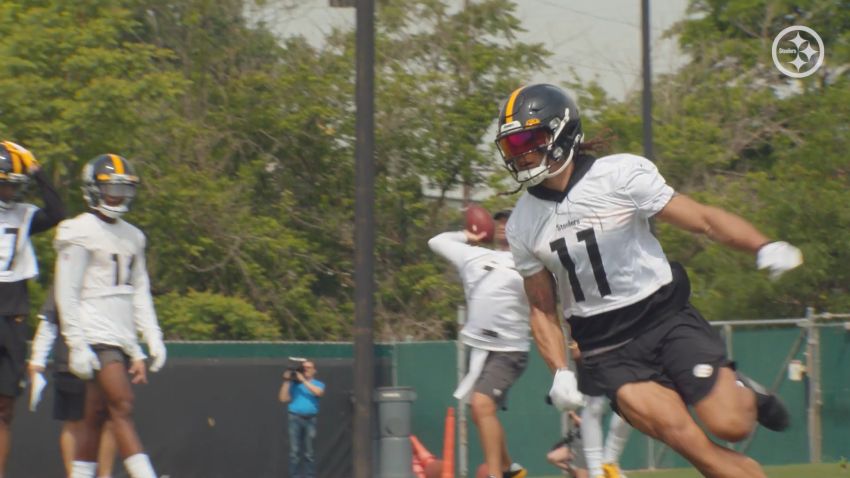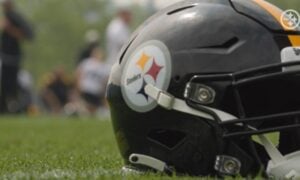When the Pittsburgh Steelers elected to select WR Chase Claypool in the second round of the 2020 NFL Draft, the perception was they were adding a height/weight/speed specimen to the receiving core that brought a physical presence and red zone threat the team hadn’t had since they shipped Martavis Bryant to the Raiders for a third-round draft pick in 2018. Claypool delivered in spades in his rookie season, recording 62 receptions for 873 yards (14.1 YPR) and nine TDs along with ten carries for 16 yards and two scores on the ground. He played all 16 games and while he only played 62% of the offensive snaps (692), he didn’t fail in providing the offense with a big-bodied presence in the end zone or along the sideline, making highlight reel-worthy contested catches and showing off his athleticism after the catch.
Naturally, we like to find player comparisons when scouting players transitioning from college to the pros and also when projecting career trajectories. For a guy like Claypool, you have to search for some physical specimens at WR to find a somewhat accurate comparison in terms of career progression. One comparison that was often referenced during the NFL Combine was none other than former Lions standout Calvin Johnson. Now when it comes to physical stature and measurables, this comparison isn’t so far-fetched, and actually is scary similar when you put the two players side-by-side in terms of what they looked like coming out.
Chase Claypool Combine Measurements:
Height: 6’4
Weight: 238lb
Arm: 32 1/2”
Hand: 9 7/8”
40: 4.42
Bench: 19
Vert: 40.5”
Broad: 126”
Calvin Johnson Combine Measurements:
Height: 6’5
Weight: 239lb
Arm: 33 3/8”
Hand: 9 1/4”
40: 4.35
Vert: 42 1/2”
Broad: 139”
While Johnson’s 40-yard dash was noticeably faster than Claypool’s the overall testing numbers are quite similar across the board. Now, when you look at statistical performance from Johnson’s rookie campaign, that matchup pretty closely to what Claypool managed in his first season in Pittsburgh. In 15 games player (10 started), Johnson saw 93 targets and hauled in 48 receptions for 756 yards (15.8 YPR) and four TD along with four carries for 52 yards. Claypool actually edged Johnson in YPG and catch % but Johnson did average more YPR while having almost an identical yard-per-target (8.1 for Johnson, 8.0 for Claypool). Johnson saw his role increase in his second season in Detroit, notching 150 targets for 78 receptions (52% catch percentage), 1,331 yards (17.1 YPR) and 12 TDs.
When watching Johnson play, you notice immediately that he does a better job stacking corners at the LOS and getting pasted them for separation on the deep ball than Claypool has shown thus far. He also is a more nuanced route runner, being able to work all quadrants of the field effectively whereas Claypool was used more in a gadget role near the LOS or deep down the field as a seam stretcher. However, both are strong combative catchers with the height, size, and leaping ability to win against defensive backs despite both receivers catch % not being all that impressive early on. It can be quite the stretch to project Claypool for a Megatron-like impact in Year Two, but the similar play styles and physical tools are there to play a similar role in Pittsburgh’s offense.
Another receiver that Claypool has often been compared to from a physical traits/rookie production standpoint is none other than Seattle’s D.K. Metcalf. While Metcalf is a freak in his own right much like Megatron, there are more things tying Metcalf to Claypool from a pedigree standpoint coming out as both were drafted in the middle-to-late second round and were seen as raw physical specimens that needed time to refine their respective games from a route running/technical perspective. As you can see below, Metcalf’s measurables and first year production match up fairly well to the two names listed above.
D.K. Metcalf Combine Measurements:
Height: 6’3
Weight: 228lb
Arm: 34 7/8”
Hand: 9 7/8”
40: 4.33
Bench: 27
Vert: 40.5”
Broad: 134”
D.K. Metcalf’s Rookie Season Stats:
100 targets, 58 receptions (58% catch percentage) for 900 yards (15.5 YPR) and seven TDs in 16 games played/15 started on 927 snaps (84%)
Again, outside of the long speed of the 40 and the ridiculous arm length, Metcalf’s numbers are pretty close to that of Claypool from a measurable standpoint. Statically, the two performed almost identically their respective rookie campaigns in terms of targets, receptions, and receiving yards with Claypool actually having more luck in the TD department despite playing about 235 less snaps than Metcalf. Now Metcalf built on his first season and exploding in his sophomore campaign, posting 129 targets which he converted in 83 receptions (64.3 catch %), 1,303 yards (15.7 YPR) and ten TDs. These numbers are almost identical to that of Calvin Johnson’s second season as posted above, noting Metcalf’s higher catch % and Johnson’s higher YPR.
When watching Metcalf’s rookie tape, it’s clear that he too separates better deep down the field than Claypool on vertical seam routes like Calvin did, possessing greater straight-line speed which can be seen in their respective testing results.
After that, you definitely can see where Metcalf was raw coming out as a pure WR, playing a similar possession-style role to Claypool along the sideline and in the red zone in his first season as he become more comfortable with the speed of the game and expanded his route tree over the middle of the field to finish his first season strong and show the improvement he did in Year Two.
However, it’s clear to see both Claypool and Metcalf are utilized in similar roles for their respective offenses based on their skillsets, making a comparison as players not too far-fetched.
Now Claypool may not ever have that deep speed ability to effectively stack defensive backs across from him and blow past them down the sideline like both Johnson and Metcalf can, but he has shown the ability to win deep as referenced in his long TD reception against the Broncos this past season. Do I personally think that Claypool can make that substantial leap from his rookie season to posting nearly 1,300 yards receiving in Year Two? I do think it’s possible, but a lot of things have to go right.
First, Claypool needs to be featured more in the offense than he was his rookie season, especially down the stretch where Mike Tomlin mentioned he wanted to save Claypool from hitting the “rookie wall” after a fast start to the season. For reference, Metcalf played nearly 300 more snaps in his sophomore season than Claypool did his rookie season, meaning he needs to be on the field more and see more targets in the passing game to get more opportunities. With the likes of JuJu Smith-Schuster, Diontae Johnson, and James Washington all vying for snaps and targets as well, it may be difficult for Claypool to reach that 80-90% snap share.
Another factor that Claypool will have to improve on is his utilization down the field and become a more well-rounded WR. Obviously, we can point to him and Ben Roethlisberger connecting more on the deep ball to improve his overall catch % and increase his YPR to above 15.0 which would put him in the same bracket as Metcalf, but I’m also suggesting his usage over the middle of the field needs to improve more in that 10-20 yard range from the LOS.
Often times Claypool was utilized on quick WR screens, drags, or slants to get him the ball in space with room to run close to the LOS or deep down the sideline on vertical patterns with seemingly little production over the intermediate area. This could be based on his need to develop more as a WR in terms of becoming a more refined route runner and separate more over the middle, but seeing as this was also an issue with Smith-Schuster, Johnson, and other targets in the passing game this past season due to the dink-and-dunk nature the offense took to finish out the season, this could be just as much of a Ben problem as it is a need for Claypool to continue his development.
Given that Calvin had the benefit of a young Matthew Stafford and Metcalf has Russell Wilson in his prime being able to deliver passes adequately in the intermediate and deep portions of the field, having Claypool take a similar step forward in terms of production may hinge on 39-year old Ben improving his completion percentage down the field which is something he hasn’t been great at the last few seasons.
In summary, I do think that outside of elite deep speed to consistently separate from coverage on the outside, Claypool has a lot of similarities to that of Metcalf and even Calvin Johnson in some ways as young, talented, and raw receivers coming into the league. This may be something that Claypool improves with time and technique though, so I don’t want to pigeon hole him saying he can’t do it.
However, for him to take that leap to a true breakout season like the others did, he will need to be featured more in the offense that already boasts a bunch of receiving options and rely on his quarterback connecting with him more on the intermediate and deep passes.
There is a possibility Tomlin cuts off the training wheels and allows OC Matt Canada to feature Claypool in his second season, moving all over the formation and getting him in advantageous matchups to exploit defenses. However, I do recognize that betting on a vast increase in snap share, improvement in utilization and passing completion percentage farther down the field, and simply being featured in the passing game with the likes of Diontae Johnson and JuJu Smith Schuster already garnering so much attention may cap the ceiling Claypool has, at least this season.
Overall, I do expect to see improvement in his game and usage in his second season, but we may be waiting till Year Three with less established targets in the passing game and a QB more willing/able to push the ball down the field to see the full breakout of Chase Claypool in Pittsburgh.
What are your expectations for Chase Claypool heading into Year Two? Do you see the similarities between he and D.K. Metcalf and even Calvin Johnson, or is he clearly a caliber below these guys as a receiver? Do you think the support is there for him to have that similar breakout campaign in his sophomore season, or do you think that circumstance will prevent him from realizing that potential in 2021? Please leave your thoughts in the comments section below and thanks again for reading!








